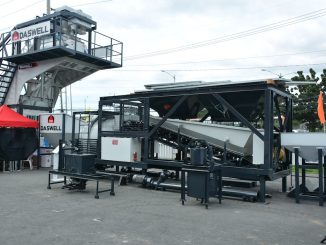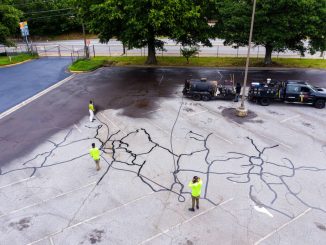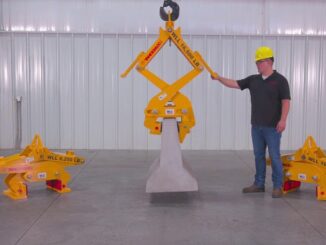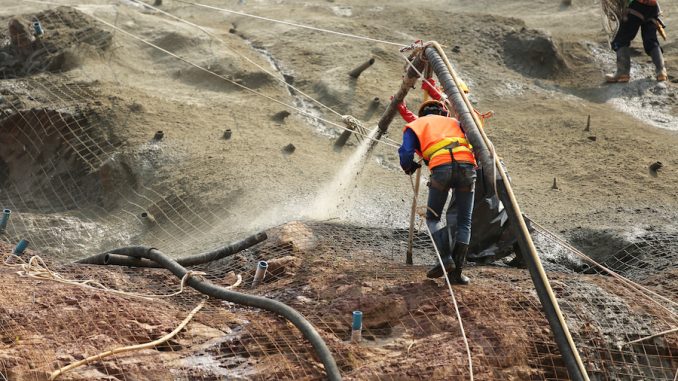
View the complete article here.
Shotcrete has revolutionized the construction industry, offering a highly efficient and versatile method for concrete application. It caters to a variety of construction needs—from structural reinforcement to creative architectural forms.
Understanding Shotcrete
Shotcrete is a unique form of concrete applied through a high-velocity hose to a surface. It’s distinguished primarily by its method of placement rather than its composition, which remains similar to traditional concrete—a mixture of cement, aggregate, and water. What makes shotcrete stand out are its two variants: dry mix and wet mix.
Dry Mix vs. Wet Mix
- Dry Mix Shotcrete (Gunite): With this process, the dry components of concrete are blended and conveyed pneumatically through a hose to the nozzle. Water is added at the nozzle just before the mixture is sprayed onto the surface. This allows for greater control over the water content, which is critical for achieving the desired consistency and strength.
- Wet Mix Shotcrete: With the wet mix process—all components, including water, are mixed before being pumped through the hose. The wet mix method facilitates a more consistent mixture and can be applied more rapidly than the dry mix.
The Shotcrete Process
As with any concrete work, surface preparation is key. For shotcrete—this involves ensuring that the surface to be sprayed is clean, structurally sound, and free of debris or contaminants that could impair the bond of the shotcrete.
Once the surface is prepped, the shotcrete is applied. For the dry mix, the nozzle operator controls the addition of water. For the wet mix, the concrete arrives ready to apply—with only the velocity of spray to be adjusted. In both methods, the nozzle is manipulated to create an even layer of concrete that adheres to the surface and begins to harden.
After application, shotcrete requires proper curing to attain its full strength. This involves maintaining the shotcrete damp for a period—often using wet burlap, plastic sheeting, or spraying with water.
Key Differences from Traditional Concrete Methods
Regarding application method, traditional concrete is poured into molds or forms—while shotcrete is sprayed onto a surface. This fundamental difference in application gives shotcrete the unique ability to be used on vertical or overhead surfaces without forms.
Traditional concrete often requires extensive formwork, which can be time-consuming and costly. Shotcrete requires minimal formwork, as it adheres to the surface and can be built up in layers.
There is a reduction in material waste with shotcrete, as it allows for precise application—even in intricate shapes and on irregular surfaces.
Shotcrete can be applied more quickly and requires fewer laborers than traditional concrete, resulting in significant time and cost savings.
Advantages of Shotcrete
Unlike traditional methods that demand the sequential steps of form construction, placement, and then pouring of concrete—shotcrete is applied directly to the surface. This cuts down on several stages, allowing for immediate application and quicker setting times. Such efficiency is particularly evident in projects with tight deadlines or the need for rapid stabilization, such as emergency repairs.
Shotcrete’s application method ensures excellent compaction and bonding to the substrate, which translates into remarkable structural strength. The force of the spray drives the material into every crevice—producing a dense, homogenous layer. This compaction reduces the likelihood of voids and results in a durable structure that often surpasses the strength of traditionally poured concrete.
One of the standout characteristics of shotcrete is its adaptability. It can be sprayed onto any type or shape of surface, from vertical walls to curved domes—without the need for elaborate formwork. This opens up a range of possibilities for creative and irregular designs that would be difficult or impossible with conventional concrete.
Traditional concrete methods are heavily reliant on formwork, which can be costly and time-consuming to erect. Shotcrete requires minimal formwork, if any at all, which not only speeds up the process but also reduces material costs.
Shotcrete’s expedited process reduces labor costs, as fewer workers are needed for application compared to traditional methods. The reduced need for formwork, coupled with the precision of the shotcrete application, diminishes material wastage. These factors contribute to overall cost savings, making shotcrete an economically attractive option for a wide range of construction projects.
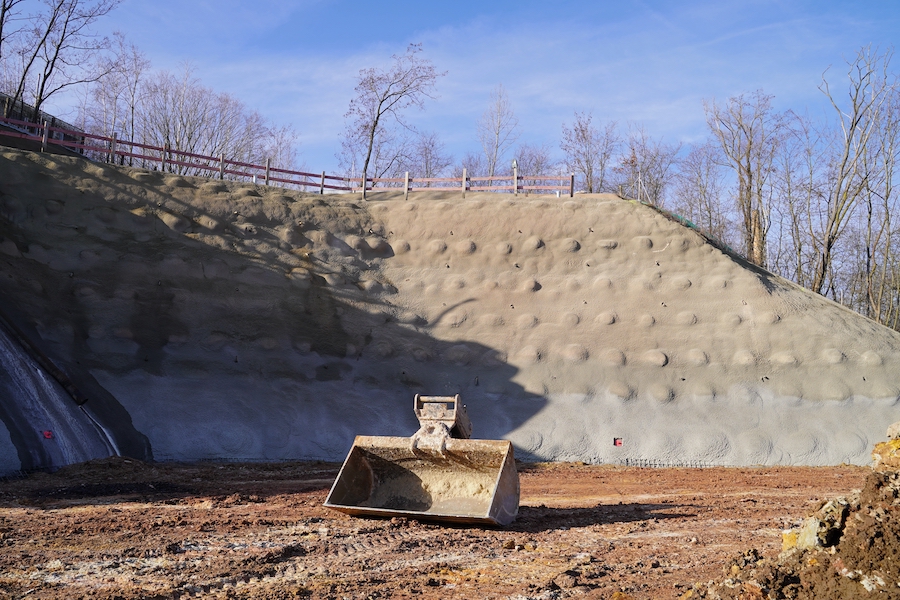
Applications of Shotcrete in Construction
There are many applications for shotcrete. Here, are just a few of the most common…
In the tunneling and mining industries, shotcrete is indispensable for its swift application and robust support capabilities. It is used to stabilize tunnel faces, create immediate structural supports, and form linings that can be applied as an integral part of the excavation cycle. This reduces the risk for workers and equipment and speeds up the overall excavation process.
Aging and deteriorating infrastructures can be restored and strengthened using shotcrete. It is particularly effective in restoring damaged concrete since it can be applied without removing the existing structure. It molds to the shape of the original surface, filling in cracks and voids—thus restoring the integrity of the structure.
Shotcrete is an excellent solution for stabilizing slopes in hilly areas prone to erosion or landslides. It can be applied to the slope surface to create a protective layer, which holds the soil in place and prevents degradation. This method is often used in conjunction with other stabilization techniques like soil nailing or the installation of mesh to reinforce the ground.
For swimming pools and skate parks, where seamless surfaces are essential for functionality and aesthetics, shotcrete is the material of choice. Its ability to form smooth, curved surfaces without joints makes it ideal for creating complex shapes that are also watertight and durable—ensuring a long-lasting, high-quality finish.
Challenges and Considerations
While shotcrete offers a range of benefits, certain challenges and environmental considerations must be navigated to ensure successful application and sustainability.
Addressing Common Misconceptions and Challenges
One prevalent misconception is that shotcrete can simply be sprayed onto any surface without preparation. However, surface prep is vital to ensure adhesion and the structural integrity of the applied concrete. Understanding the nuances of shotcrete, such as the differences between the dry and wet mix and when to use each, is essential.
The rebound, which is the material that bounces back from the surface during application, poses a challenge. It cannot be reused and affects the overall strength and finish of the shotcrete if not managed properly. In addition—achieving uniform thickness and preventing sagging, especially in overhead applications, requires skill and experience.
Environmental Considerations and Mitigation Strategies
Environmental impacts arise from dust generation, especially with dry-mix shotcrete. Mitigation strategies include using misting systems to control dust or opting for the wet-mix process, which generates less airborne particulate matter. In addition—the noise from shotcrete equipment can be significant, and should be addressed through the use of sound barriers or by limiting the hours of operation.
Responsible sourcing of materials, optimizing mix designs for strength and durability to reduce the volume of concrete used, and prioritizing the use of recycled materials when possible can all contribute to reducing the environmental footprint of shotcrete applications.
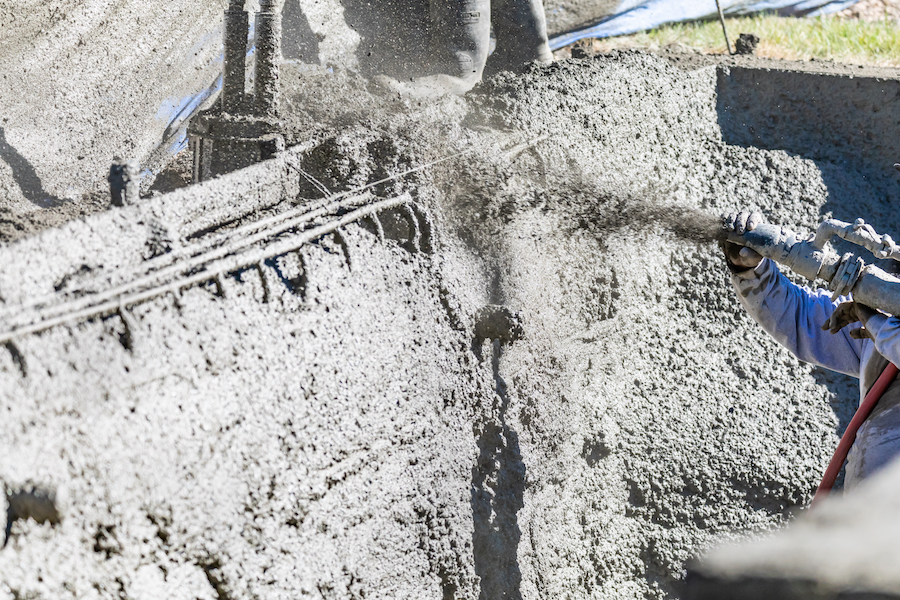
Best Practices for Shotcrete Application
The benefits of shotcrete are maximized when best practices in its application are followed. Below are the essential practices that ensure the highest quality and efficiency in shotcrete construction projects.
Equipment and Material Selection for Optimal Results
Choosing the right equipment and materials is crucial for shotcrete success. Pumps and nozzles should be selected based on the type of shotcrete mix being used and the specific requirements of the project. The aggregate size, type of cement, and additives need to be compatible with the application equipment and the desired finish. Regular maintenance of equipment is also critical to prevent blockages and ensure a consistent spray.
Training and Skill Development for Contractors and Crews
The skill of the nozzle operator is pivotal in the shotcrete process. Proper training ensures that operators understand how to adjust the velocity and angle of the shotcrete stream for even coverage and optimal compaction. Crews must also be trained in surface preparation, curing practices, and safety measures specific to shotcrete application.
Ensuring Quality Control and Adherence to Standards
Quality control starts with the mix design and extends through to the application and curing processes. Adhering to recognized standards, such as those from the American Shotcrete Association or similar organizations, helps to maintain consistency and structural integrity. Regular testing of the shotcrete, such as performing core compressive strength tests, ensures the material meets the project specifications.
By adhering to these best practices, contractors can deliver projects that fully harness the advantages of shotcrete—achieving a balance between cost, time efficiency, and superior structural performance.
View the complete article here.
What is the main difference between dry mix and wet mix shotcrete?
Dry mix shotcrete adds water at the nozzle, while wet mix shotcrete has all components mixed before being pumped.
What are the primary advantages of using shotcrete over traditional concrete methods?
Shotcrete requires minimal formwork, allows for precise application, and is faster and more cost-effective than traditional concrete methods.






































